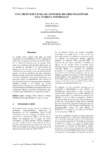Mostrar o rexistro simple do ítem
Una propuesta para el control de orientación de una turbina windfloat
| dc.contributor.author | Horno, Leticia del | |
| dc.contributor.author | Somolinos, José A. | |
| dc.contributor.author | Segura, Eva | |
| dc.contributor.author | Morales, Rafael | |
| dc.date.accessioned | 2021-08-24T10:16:18Z | |
| dc.date.available | 2021-08-24T10:16:18Z | |
| dc.date.issued | 2021 | |
| dc.identifier.citation | Horno, L. del, Somolinos, J.A., Segura, E., Morales, R. Una propuesta para el control de orientación de una turbina windfloat. En XLII Jornadas de Automática: libro de actas. Castelló, 1-3 de septiembre de 2021 (pp. 45-53). DOI capítulo: https://doi.org/10.17979/spudc.9788497498043.045 DOI libro: https://doi.org/10.17979/spudc.9788497498043 | es_ES |
| dc.identifier.isbn | 978-84-9749-804-3 | |
| dc.identifier.uri | http://hdl.handle.net/2183/28285 | |
| dc.description.abstract | [Resumen] La energía eólica marina debe jugar un papel importante en el cumplimiento de los compromisos ambientales asumidos en el Acuerdo de París. El uso de las soluciones flotantes para la energía eólica fuera-costa (offshore) está ganando importancia, ya que permite la expansión a un gran número de regiones en las que esto no ha sido técnicamente factible hasta ahora debido a la profundidad del lecho marino. Uno de los problemas de estas estructuras flotantes son las oscilaciones producidas por las olas y el viento, debiéndose evitar que la inclinación de la estructura supere un determinado valor durante la fase de operación. Este trabajo presenta un modelado dinámico sencillo y un sistema de control multivariable no lineal para una turbina Windfloat. Su función principal es mantener el aerogenerador en las condiciones óptimas requeridas de orientación para un mayor aprovechamiento de la energía del viento. | es_ES |
| dc.description.abstract | [Abstract] Offshore wind power is called upon to play an important role in fulfilling the environmental commitments acquired in the Paris Agreement. The use of floating solutions for offshore wind energy is gaining importance as it allows expansion to many regions where this has not been technically feasible until now due to depth. One of the problems of these floating structures is the oscillations produced by the waves and the wind, and the inclination of the structure must be prevented from exceeding a particular value during the operation phase. This work presents a simple dynamic model and a nonlinear multivariable control system for a Windfloat turbine. Its principal function is to keep the wind turbine in the optimal conditions required to use wind energy better. | es_ES |
| dc.description.uri | https://doi.org/10.17979/spudc.9788497498043 | |
| dc.language.iso | spa | es_ES |
| dc.publisher | Universidade da Coruña, Servizo de Publicacións | es_ES |
| dc.relation.uri | https://doi.org/10.17979/spudc.9788497498043.045 | es_ES |
| dc.rights | Atribución-NoComercial-CompartirIgual 4.0 Internacional (CC BY-NC-SA 4.0) | es_ES |
| dc.rights.uri | https://creativecommons.org/licenses/by-nc-sa/4.0/deed.es | * |
| dc.subject | Energía eólica marina | es_ES |
| dc.subject | Turbinas windfloat | es_ES |
| dc.subject | Modelado dinámico | es_ES |
| dc.subject | Control no lineal | es_ES |
| dc.subject | Offshore wind energy | es_ES |
| dc.subject | Windfloat turbines | es_ES |
| dc.subject | Dynamic modeling | es_ES |
| dc.subject | Nonlinear control | es_ES |
| dc.title | Una propuesta para el control de orientación de una turbina windfloat | es_ES |
| dc.title.alternative | A Proposal for the Closed-Loop Orientation Control of a Windfloat Turbine System | es_ES |
| dc.type | info:eu-repo/semantics/conferenceObject | es_ES |
| dc.rights.access | info:eu-repo/semantics/openAccess | es_ES |
| UDC.startPage | 45 | es_ES |
| UDC.endPage | 53 | es_ES |
| dc.identifier.doi | 10.17979/spudc.9788497498043.045 | |
| UDC.conferenceTitle | XLII Jornadas de Automática | es_ES |






